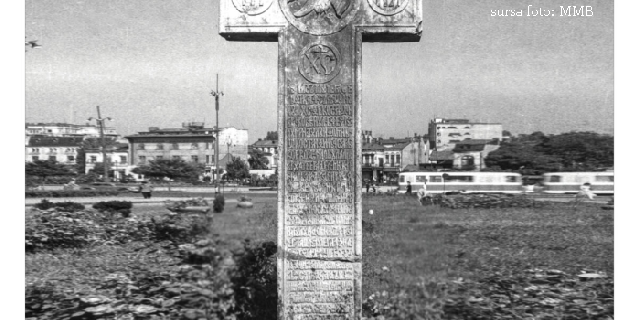Bucharest’s stone crosses and their history
Stone-carved inscriptions on crosses as rich historical evidence

Steliu Lambru, 29.10.2023, 14:00
The man of the past, from time immemorial, felt the
need to bequeath to the future generations signs of his presence in this world.
Until writing was discovered, man expressed his thoughts through rupestrian
drawings, or through several objects, adorned or painted. When writing proper
appeared, messages and thoughts for posterity became more elaborated, enabling
us to know more about the perceptions of the past. As for the messages carved
in stone, they were among the most perennial ones, standing the test of time to
this day. When we speak about the messages carved in stone, what mainly comes
to mind is the ancient period, with its spectacular temples, statues, and
tombs. However, apart from the ancient period, in timeframes closer to our
times, texts carved in stone are quite a few and no less important, at that.
In 19th century Romanian
society, the force of the messages carved in stone was impressive, especially
when we speak about the messages engraved on crosses. In the city of Bucharest
two centuries ago, stone immortalized what then the Bucharesters thought it was
worth reminiscing.
Cezar Buiumaci is a museographer
with the museum of Bucharest Municipality. Also, he is a hunter of the city’s
stone crosses and of the messages engraved on them.
Cezar Buiumaci:
In the present research I found two crosses we seem to have lost track
of. We’re speaking about Ioan
Pometcovici’s cross, a fountain cross in the Ferentari neighborhood and which
today can be found in the Bellu cemetery, at the tomb of general Gheorghe Brătianu.
It was a fountain cross that changed its purpose, becoming a funeral cross.
That is the model, a matrix, just as it happens with all crosses around
Bucharest. The other cross is Miloradovici’s cross, another cross which is a reminder
of Russian troops’ win over the Turks. General Miloradovici was the one who
succeeded to have the battle sidestep Bucharest and was thus dubbed the savior
of Bucharest. A cross was erected in remembrance of that, it was a cross that
can be found on the Patriarchate Hill, close to the belfry.
The
strongest messages carved in the stones of 19th century Bucharest are
those carved on crosses. The cross is one of the oldest universal symbols that existed
before Christianity. However, it was Christianity that brought the cross center-stage.
The four arms of the cross signify the great axes of the world and the physical
coordinates underlying man’s endeavor to build hid own material world. So the
cross was the basic element on which messages for eternity could be drawn or
written in a concise manner. For instance, on Tanase the Shoemaker’s Cross which
today can be found in Ferentari neighborhood, located in the south-west of
Bucharest, the Biblical scene of the Annunciation can be seen. The profile of kneeling
Virgin Mary is to the right, while to the left, Archangel Gabriel can be seen
standing. A bunch of rays signifying the presence of the Holy Ghost is drawn
above. The inscription is in Romanian, but it is written in the Cyrillic
alphabet, still in use in 1829, the year when the cross and the water fountain were built. The inscription runs as follows: With the mercy and help of the one who in
Trinity is most glorified, God, this cross was erected, to the glory of the
Annunciation of the Purest Mother, and this water fountain was also built.
A key aspect of the messages carved
in stone is made not only by the abstract side of life, but also by its
material side, a fountain, in our case. Cezar Buiumaci emphasizes the bond
between spirit and matter in the messages he found on Bucharest’s stone crosses, which he studied. One such cross is that in the Putul cu Tei street, which
can be found in Bucharest’s present-day neighborhood, Berceni.
Cezar Buiumaci:
The cross in the Bellu district was placed, according to
various authors, in the time of the pandours, in 1821, or in the time of the eighteen
forty-eight revolutionaries. The truth lies somewhere in between, it was
commissioned in 1831. It is a fountain cross, erected on a greenfield land on the Putul cu Tei street, lying a couple of meters away. It was
customary for a tree to be planted and for a cross to be erected, whenever a
fountain was dug. It was a gesture of great humaneness to offer water to the thirsty
traveler, at a time when water supply networks did not exist. Concurrently, the fountains
had the economic function of providing water to the livestock or for irrigation.
There where this cross was found, the vineyards site began, on the Vineyards
Hill. The story usually went like this: the traveler would arrive, he would
quench his thirst and sit in the shade. That is how he took the time to read the diptych
those who erected the cross had inscribed on it. Thus they organized their own
alms when they were still alive.
The messages found on stone crosses
are messages of gratitude, yet they are also message of triumph, such as the
one on the cross erected by Wallachian ruling prince Leon Voda, in 1631, by
means of which he marked his win over the enemy. There are also messages inscribed
as a lament for the departed ones whom someone held most dear, such as the
message on the cross of the great boyar Papa Brâncoveanu, who was killed in
1655 during an uprising. Such an example is one of the many examples available.
We can thus view diversity as a stone-carved chronicle of Bucharest history.






























